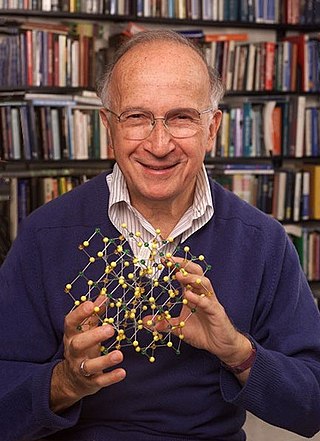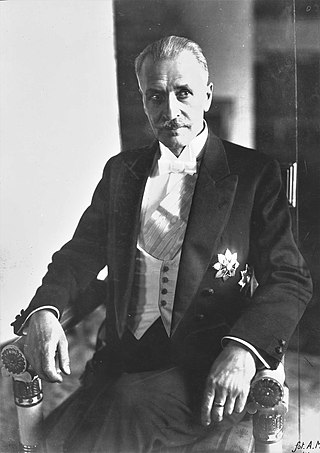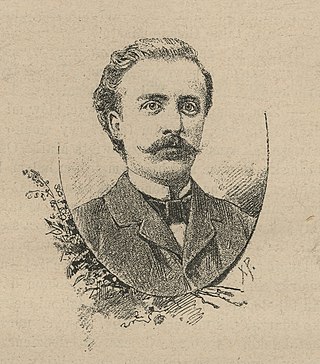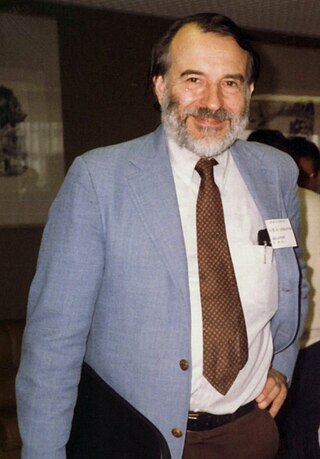
Marie Salomea Skłodowska–Curie was a Polish and naturalized-French physicist and chemist who conducted pioneering research on radioactivity. She was the first woman to win a Nobel Prize, the first person to win a Nobel Prize twice, and the only person to win a Nobel Prize in two scientific fields. Her husband, Pierre Curie, was a co-winner of her first Nobel Prize, making them the first-ever married couple to win the Nobel Prize and launching the Curie family legacy of five Nobel Prizes. She was, in 1906, the first woman to become a professor at the University of Paris.

Roald Hoffmann is a Polish-American theoretical chemist who won the 1981 Nobel Prize in Chemistry. He has also published plays and poetry. He is the Frank H. T. Rhodes Professor of Humane Letters, Emeritus, at Cornell University, in Ithaca, New York.

Ignacy Mościcki was a Polish chemist and politician who was the country's president from 1926 to 1939. He was the longest serving president in Polish history. Mościcki was the President of Poland when Germany invaded the country on 1 September 1939 and started World War II.

Lviv Polytechnic National University is the largest scientific university in Lviv, Ukraine. Since its foundation in 1816, it has been one of the most important centres of science and technological development in Central Europe. In the interbellum period, the Polytechnic was one of the most important technical colleges in Poland, together with the Warsaw Polytechnic. In 2020, Lviv Polytechnic was ranked globally among the top 1000 universities according to Times Higher Education. As of 2019, there were approximately 35,000 students in the university.

Józef Jerzy Boguski was a Polish chemist and a professor at the Warsaw Polytechnic.

The Maria Sklodowska-Curie National Research Institute of Oncology is a specialized research institute and hospital of the Polish Ministry of Health. Based in Warsaw, it also has regional branches in Gliwice and Kraków. It was founded in 1932 as the Radium Institute by double-Nobel laureate Maria Skłodowska-Curie in collaboration with the Polish Government, especially President Ignacy Mościcki.

Paul von Ragué Schleyer was an American physical organic chemist whose research is cited with great frequency. A 1997 survey indicated that Dr. Schleyer was, at the time, the world's third most cited chemist, with over 1100 technical papers produced. He was Eugene Higgins Professor of Chemistry at Princeton University, Professor and co-director of the Institute for Organic Chemistry at the University of Erlangen–Nuremberg in Germany, and later Graham Perdue Professor of Chemistry at the University of Georgia in Athens, Georgia. He published twelve books in the fields of lithium chemistry, ab initio molecular orbital theory and carbonium ions. He was past president of the World Association of Theoretically Oriented Chemists, a fellow of the International Academy of Quantum Molecular Science and editor-in-chief of the Encyclopedia of Computational Chemistry.
James Riddick Partington was a British chemist and historian of chemistry who published multiple books and articles in scientific magazines. His most famous works were An Advanced Treatise on Physical Chemistry and A History of Chemistry, for which he received the Dexter Award and the George Sarton Medal.
The European Chemical Society (EuChemS) is a European non-profit organisation which promotes collaboration between non-profit scientific and technical societies in the field of chemistry.
Arthur Wilson Adamson was an American chemist who is considered a pioneer in inorganic photochemistry. His research made significant contributions to the understanding of physical adsorption and contact angle phenomena, and the thermodynamics of surfaces and irreversible adsorption.
Mietek Jaroniec is a Polish and American chemist and an author of over 950 scientific papers which got over 20,000 citations and brings him an h-index of 63.

Chemistry Europe is an organization of 16 chemical societies from 15 European countries, representing over 75,000 chemists. It publishes a family of academic chemistry journals, covering a broad range of disciplines.

This is a list of women chemists. It should include those who have been important to the development or practice of chemistry. Their research or application has made significant contributions in the area of basic or applied chemistry.

Józef Wierusz-Kowalski was a Polish physicist and diplomat. He discovered the phenomenon of progressive phosphorescence. He served as Rector of the University of Freiburg, and helped to establish the section for physics at the reopened University of Warsaw. After Polish independence was established, he served as the Polish ambassador to the Holy See, the Netherlands, Austria and Turkey.
Partha Sarathi Mukherjee is an Indian inorganic chemist and a professor at the Inorganic and Physical Chemistry department of the Indian Institute of Science. He is known for his studies on organic nano structures, molecular sensors and catalysis in nanocages and is a recipient of the Swarnajayanthi Fellowship of the Department of Science and Technology and the Bronze Medal of the Chemical Research Society of India. The Council of Scientific and Industrial Research, the apex agency of the Government of India for scientific research, awarded him the Shanti Swarup Bhatnagar Prize for Science and Technology, one of the highest Indian science awards, in 2016, for his contributions to chemical sciences.
The Polish Radiation Research Society (PRRS) (Polish: Polskie Towarzystwo Badań Radiacyjnych), memorial to Maria Skłodowska-Curie, is a scientific association of professional researchers and amateurs interested in the studies of radiation interactions with matter.
The Polish Physical Society is a professional scientific society of Polish physicists.
The Marie Curie-Skłodowska Medal is a Polish annual science award conferred by the Polish Chemical Society to scientists working permanently abroad for contributions in the field of chemistry.

Ignacy Misiąg was a Polish infantry colonel who was most notable for his service in World War II.












